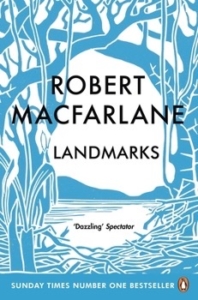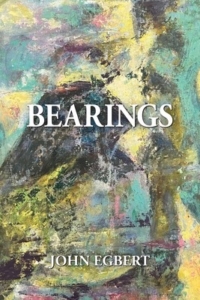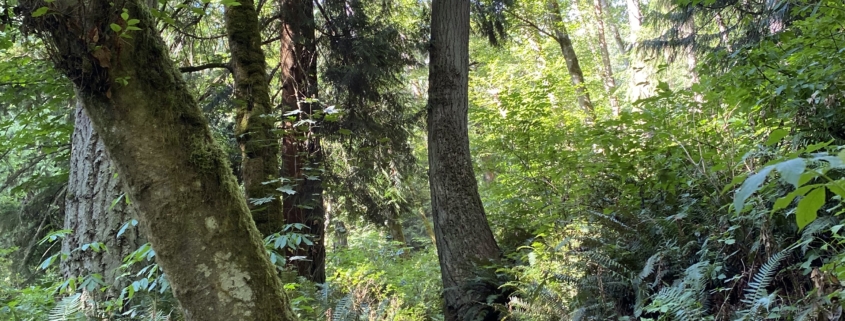John Egbert, BEARINGS
BEARINGS, John Egbert. Bellingham, WA, 2024, 102 pages, $15.99, paper.
LANDMARKS, Robert Macfarlane. Penguin, UK, 2016, 448 pages, $18.00, paper, penguin.co.uk.
Landmarks is about language, specifically it is about language that describes land. “It is a field guide to literature I  love,” Macfarlane writes, “and it is a word-hoard of the astonishing lexis of landscape that exists in the comprision of islands, rivers, strands, fells, lochs, cities, towns, corries, hedgerows, fields and edgelands uneasily known as Britain and Ireland” (p. 1). I love this book, and, likewise, feel immensely lucky to have been gifted a copy of Bearings, poems by Bellingham writer, naturalist, world-traveler, and teacher John Egbert.
love,” Macfarlane writes, “and it is a word-hoard of the astonishing lexis of landscape that exists in the comprision of islands, rivers, strands, fells, lochs, cities, towns, corries, hedgerows, fields and edgelands uneasily known as Britain and Ireland” (p. 1). I love this book, and, likewise, feel immensely lucky to have been gifted a copy of Bearings, poems by Bellingham writer, naturalist, world-traveler, and teacher John Egbert.
I am one of the people thanked in the acknowledgments in Bearings, and I know this book well. Even so, sitting down and reading it all at once, cover-to-cover, wholly engaged me. Egbert is someone who understands the importance of getting one’s bearings in unfamiliar territory, and he helps his readers get their bearings. The poems are—mostly—set in Bellingham and the southwest United States, but he shares Macfarlane’s dizzy romance with exploration, and with precise words, populating his lines with yellow-breasted meadowlarks, river trout, plant names both Latin and common, a carillon of finches, the great horned owl. All the way through—even when the territory is wholly unfamiliar—the reader is in the hands of a sure-footed guide.
Consider this  stanza from a poem set in South America, in Brazil, where I’ve never been:
stanza from a poem set in South America, in Brazil, where I’ve never been:
A yellow-breasted flycatcher
sallies from the bridge,
snags a big black beetle.
Crook-necked egrets,
like white-tied Brazilian buskers,
cruise by on hyacinth islets
ripped loose from the Pantanal.—from “Barge Fishing”
Reading these lines, I’m immersed in the scene. The words themselves (as Macfarlane insists) are poems.
The urgency of such naming—how it should and must matter more to all of us—is heightened in Macfarlane’s Landmarks. In chapter one, Macfarlane talks about a peat glossary (which he will later discuss at length), and contextualizes his discovery with this paragraph:
The same year I first saw the Peat Glossary, a new edition of the Oxford Junior Dictionary was published. A sharp-eyed reader noticed that there had been a culling of words concerning nature. Under pressure, Oxford University Press revealed a list of entries it no longer felt to be relevant to a modern-day childhood. The deletions included acorn, adder, ash, beech, bluebell, buttercup, catkin, conker, cowslip, cygnet, dandelion, fern, hazel, heather, heron, ivy, kingfisher, lark, mistletoe, nectar, newt, otter, pasture, and willow. The words introduced to the new edition included attachment, block-graph, broadband, bullet-point, celebrity, chatroom, committee…. (p. 3)
Egbert’s poems—which span from his childhood in the 1950s to now—encompass practically every one of these deleted words. The poems are nature poems, fishing poems, and sometimes nonsense poems meant to tickle a grandchild, but in every poem we encounter a poet in love with precise, specific language.
Arroyo Cairns
I walk this arroyo cut down
below stuccoed walls
baring roots of junipers and pines.
I love this slice of nature pie,
sluice of feldspar grays and pinks,
green epidote and white quartz,
a bull snake skin curling through
camel humps of sand,
a Scrub Jay begging me to disappear.You, the artist arrive
like some ancient Native initiate,
some finger-painting kindergarten kid,
come to stack stones
as if to sanctify reparations for all of us
who have carved or cast this earth.August’s flood sweeps away
rabbit pellets, pinon hulls,
a towhee’s white tail feather.
Footprints vanish.
Cairns survive.—Santa Fe, New Mexico, 2015
—John Egbert
“’The hardest thing of all to see is what is really there,’” Macfarlane reminds us, quoting from The Peregrine by J. A. Baker. In Bearings we are reminded that seeing what’s there is worth the effort. The poems were written over many years, but, as Egbert writes in his introduction, “Paying attention is its own trip,” and: “Reading my own work has helped deepen my past and, I hope, be open to more people and to nature’s surprising complexity” (p. vii).
Landmarks has been around for awhile; I found a copy at my local library, and ordered my own copy (to mark up) from Thriftbooks.com.
Bearings is brand new (and also features gorgeous drawings by Laurie Egbert); you can find a copy via Village Books, at this link: https://www.villagebooks.com/book/9798218412616.




Bethany: Who would want to trade buttercup for bullet-point!
Thank you for bringing these lovely books to our attention in such a masterful way.
Thank you for commenting, and, believe me, it is my pleasure 🙂